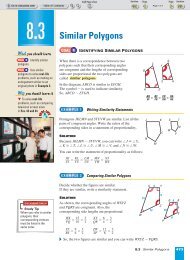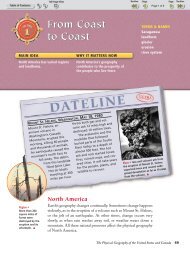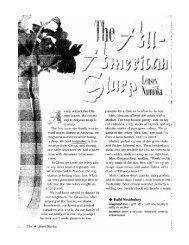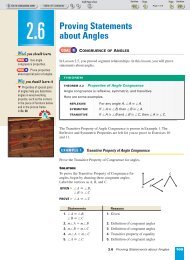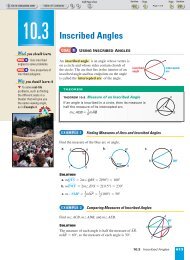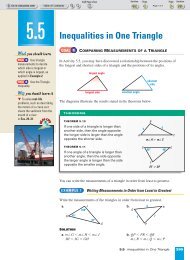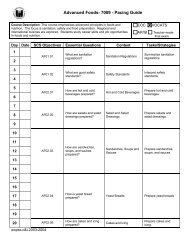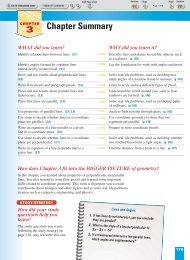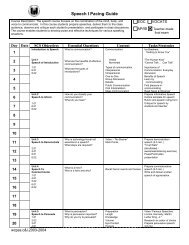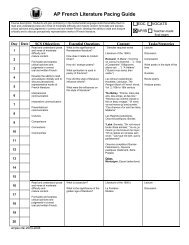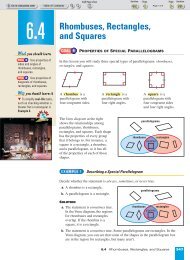4-5 Using Congruent Triangles - Nexuslearning.net
4-5 Using Congruent Triangles - Nexuslearning.net
4-5 Using Congruent Triangles - Nexuslearning.net
Create successful ePaper yourself
Turn your PDF publications into a flip-book with our unique Google optimized e-Paper software.
4.5<br />
What you should learn<br />
GOAL 1 Use congruent<br />
triangles to plan and write<br />
proofs.<br />
GOAL 2 Use congruent<br />
triangles to prove<br />
constructions are valid.<br />
Why you should learn it<br />
<strong>Congruent</strong> triangles are<br />
important in real-life<br />
problems, such as in<br />
designing and constructing<br />
bridges like the one<br />
in Ex. 16.<br />
REAL<br />
REAL LIFE<br />
LIFE<br />
<strong>Using</strong> <strong>Congruent</strong> <strong>Triangles</strong><br />
GOAL 1<br />
PLANNING A PROOF<br />
Knowing that all pairs of corresponding parts of<br />
congruent triangles are congruent can help you<br />
reach conclusions about congruent figures.<br />
For instance, suppose you want to prove that<br />
PQS £ RQS in the diagram shown at the<br />
right. One way to do this is to show that<br />
¤PQS £ ¤RQS by the SSS Congruence<br />
Postulate. Then you can use the fact that<br />
corresponding parts of congruent triangles are<br />
congruent to conclude that PQS £ RQS.<br />
EXAMPLE 1<br />
GIVEN AB<br />
Æ ∞ CD Æ , BC Æ ∞ DA<br />
Æ<br />
PROVE AB<br />
Æ £ CD Æ<br />
Planning and Writing a Proof<br />
Plan for Proof Show that ¤ABD £ ¤CDB.<br />
Then use the fact that corresponding parts of<br />
congruent triangles are congruent.<br />
SOLUTION<br />
First copy the diagram and mark it with the given information. Then mark any<br />
additional information that you can deduce. Because AB<br />
Æ and CD Æ are parallel<br />
segments intersected by a transversal, and BC Æ and DA<br />
Æ are parallel segments<br />
intersected by a transversal, you can deduce that two pairs of alternate interior angles<br />
are congruent.<br />
A<br />
Mark given information. Add deduced information.<br />
B<br />
D<br />
C<br />
P R<br />
Paragraph Proof Because AB<br />
Æ ∞ CD Æ , it follows from the Alternate Interior<br />
Angles Theorem that ABD £ CDB. For the same reason, ADB £ CBD<br />
because BC Æ ∞ DA<br />
Æ . By the Reflexive Property of Congruence, BD Æ £ BD Æ . You can<br />
use the ASA Congruence Postulate to conclude that ¤ABD £ ¤CDB. Finally,<br />
because corresponding parts of congruent triangles are congruent, it follows<br />
that AB<br />
Æ £ CD Æ .<br />
A<br />
B<br />
A<br />
B<br />
D<br />
4.5 <strong>Using</strong> <strong>Congruent</strong> <strong>Triangles</strong> 229<br />
q<br />
S<br />
C<br />
D<br />
C
STUDENT HELP<br />
Proof<br />
HOMEWORK<br />
HELP<br />
Visit our Web site at<br />
www.mcdougallittell.com<br />
for extra examples.<br />
INTERNET<br />
EXAMPLE 2<br />
230 Chapter 4 <strong>Congruent</strong> <strong>Triangles</strong><br />
Planning and Writing a Proof<br />
GIVEN A is the midpoint of MT<br />
Æ ,<br />
A is the midpoint of SR<br />
Æ .<br />
PROVE MS<br />
Æ ∞ TR<br />
Æ<br />
Plan for Proof Prove that ¤MAS £ ¤TAR. Then use the fact that<br />
corresponding parts of congruent triangles are congruent to show that<br />
M £ T. Because these angles are formed by two segments intersected<br />
by a transversal, you can conclude that MS<br />
Æ ∞ TR<br />
Æ .<br />
1. A is the midpoint of MT<br />
Æ ,<br />
A is the midpoint of SR<br />
1. Given<br />
Æ .<br />
2. MA<br />
Æ £ TA<br />
Æ , SA<br />
Æ £ RA<br />
Æ<br />
Statements Reasons<br />
2. Definition of midpoint<br />
3. MAS £ TAR 3. Vertical Angles Theorem<br />
4. ¤MAS £ ¤TAR 4. SAS Congruence Postulate<br />
5. M £ T 5. Corresp. parts of £ ◊ are £.<br />
6. MS<br />
Æ ∞ TR<br />
Æ<br />
6. Alternate Interior Angles Converse<br />
EXAMPLE 3<br />
GIVEN 1 £ 2<br />
3 £ 4<br />
PROVE ¤BCE £ ¤DCE<br />
<strong>Using</strong> More than One Pair of <strong>Triangles</strong><br />
2 E 4<br />
C A<br />
1<br />
3<br />
Plan for Proof The only information you have about ¤BCE and ¤DCE is<br />
that 1 £ 2 and that CE<br />
Æ £ CE<br />
Æ . Notice, however, that sides BC Æ and DC Æ<br />
are also sides of ¤ABC and ¤ADC. If you can prove that ¤ABC £ ¤ADC,<br />
you can use the fact that corresponding parts of congruent triangles are<br />
congruent to get a third piece of information about ¤BCE and ¤DCE.<br />
Statements Reasons<br />
1. 1 £ 2 1. Given<br />
3 £ 4<br />
2. AC Æ £ AC Æ<br />
2. Reflexive Property of Congruence<br />
3. ¤ABC £ ¤ADC 3. ASA Congruence Postulate<br />
4. BC Æ £ DC Æ<br />
4. Corresp. parts of £ ◊ are £.<br />
5. CE<br />
Æ £ CE<br />
Æ<br />
5. Reflexive Property of Congruence<br />
6. ¤BCE £ ¤DCE 6. SAS Congruence Postulate<br />
S<br />
M<br />
D<br />
B<br />
A<br />
T<br />
R
STUDENT HELP<br />
Look Back<br />
For help with copying an<br />
angle, see p. 159.<br />
Proof<br />
GOAL 2<br />
PROVING CONSTRUCTIONS ARE VALID<br />
In Lesson 3.5, you learned how to copy an angle using a compass and a<br />
straightedge. The construction is summarized below. You can use congruent<br />
triangles to prove that this (and other) constructions are valid.<br />
1<br />
A<br />
D<br />
To copy A, first draw<br />
a ray with initial point<br />
D. Then use the same<br />
compass setting to<br />
draw an arc with center<br />
A and an arc with<br />
center D. Label points<br />
B, C, and E.<br />
EXAMPLE 4<br />
Proving a Construction<br />
<strong>Using</strong> the construction summarized above, you can<br />
copy CAB to form FDE. Write a proof to verify<br />
that the construction is valid.<br />
Plan for Proof Show that ¤CAB £ ¤FDE. Then use<br />
the fact that corresponding parts of congruent triangles<br />
are congruent to conclude that CAB £ FDE. By<br />
construction, you can assume the following statements<br />
as given.<br />
Æ Æ<br />
AB £ DE Same compass setting is used.<br />
Æ Æ<br />
AC £ DF Same compass setting is used.<br />
BC Æ £ EF<br />
Æ Same compass setting is used.<br />
SOLUTION<br />
1. AB<br />
Æ £ DE<br />
Æ<br />
Statements Reasons<br />
1. Given<br />
Æ<br />
2. AC Æ £ DF<br />
Æ<br />
3. BC Æ £ EF<br />
C<br />
B<br />
E<br />
2<br />
Draw an arc with<br />
radius BC and center<br />
E. Label the<br />
intersection F.<br />
2. Given<br />
3. Given<br />
4. ¤CAB £ ¤FDE 4. SSS Congruence Postulate<br />
A<br />
5. CAB £ FDE 5. Corresp. parts of £ ◊ are £.<br />
D<br />
C<br />
F<br />
B<br />
E<br />
3<br />
A<br />
D<br />
A<br />
D<br />
Draw DF<br />
Æ˘ .<br />
FDE £ CAB<br />
4.5 <strong>Using</strong> <strong>Congruent</strong> <strong>Triangles</strong> 231<br />
C<br />
F<br />
B<br />
E<br />
C<br />
F<br />
B<br />
E
GUIDED PRACTICE<br />
Concept Check ✓<br />
Skill Check ✓<br />
232 Chapter 4 <strong>Congruent</strong> <strong>Triangles</strong><br />
In Exercises 1–3, use the photo of the eagle ray.<br />
1. To prove that PQT £ RQT,<br />
which triangles might you prove<br />
to be congruent?<br />
2. If you know that the opposite sides<br />
of figure PQRS are parallel, can you<br />
prove that ¤PQT £ ¤RST? Explain.<br />
3. The statements listed below are not in<br />
order. Use the photo to order them as<br />
statements in a two-column proof.<br />
Write a reason for each statement.<br />
GIVEN QS<br />
Æ fi RP<br />
Æ , PT<br />
Æ £ RT<br />
Æ<br />
PROVE PS<br />
Æ £ RS<br />
Æ<br />
A. QS<br />
Æ fi RP<br />
Æ<br />
B. ¤PTS £ ¤RTS C. PTS £ RTS<br />
D. PS<br />
Æ £ RS<br />
Æ<br />
PRACTICE AND APPLICATIONS<br />
STUDENT HELP<br />
Extra Practice<br />
to help you master<br />
skills is on p. 810.<br />
STUDENT HELP<br />
HOMEWORK HELP<br />
Example 1: Exs. 4–14,<br />
17, 18<br />
Example 2: Exs. 14, 17, 18<br />
Example 3: Exs. 15, 16<br />
Example 4: Exs. 19–21 M<br />
E. PT<br />
Æ £ RT<br />
Æ<br />
G. PTS and RTS are right angles.<br />
F. TS Æ £ TS<br />
Æ<br />
STAINED GLASS WINDOW The eight window panes in the diagram<br />
are isosceles triangles. The bases of the eight triangles are congruent.<br />
4. Explain how you know that ¤NUP £ ¤PUQ.<br />
N<br />
5. Explain how you know that ¤NUP £ ¤QUR.<br />
M<br />
P<br />
6. Do you have enough information to prove that all<br />
the triangles are congruent? Explain.<br />
7. Explain how you know that UNP £ UPQ.<br />
U<br />
L q<br />
DEVELOPING PROOF State which postulate or theorem you can use to<br />
prove that the triangles are congruent. Then explain how proving that the<br />
triangles are congruent proves the given statement.<br />
8. PROVE ML<br />
Æ £ QL<br />
Æ 9. PROVE STV £ UVT 10. PROVE KL = NL<br />
N P<br />
L<br />
q<br />
S<br />
T<br />
V U<br />
T<br />
K<br />
J<br />
S<br />
L<br />
R<br />
M<br />
N
CAT’S CRADLE Use the diagram of the string game Cat’s Cradle<br />
and the information given below.<br />
GIVEN ¤EDA £ ¤BCF<br />
¤AGD £ ¤FHC<br />
¤BFC £ ¤ECF<br />
11. PROVE GD Æ £ HC Æ<br />
12. PROVE CBH £ FEH<br />
13. PROVE AE<br />
Æ £ FB<br />
Æ<br />
14. DEVELOPING PROOF Complete<br />
the proof that BAC £ DBE.<br />
GIVEN B is the midpoint of AD Æ ,<br />
C £ E, BC Æ ∞ DE<br />
Æ<br />
PROVE BAC £ DBE<br />
Statements Reasons<br />
15. DEVELOPING PROOF Complete<br />
the proof that ¤AFB £ ¤EFD.<br />
GIVEN 1 £ 2<br />
3 £ 4<br />
PROVE AFB £ EFD<br />
A<br />
B<br />
C<br />
D<br />
A<br />
G<br />
H<br />
B C<br />
1. B is the midpoint of AD Æ . 1. Given<br />
2. AB<br />
Æ £ BD Æ<br />
2. ?<br />
3. C £ E 3. Given<br />
4. BC Æ ∞ DE<br />
Æ<br />
4. Given<br />
5. EDB £ CBA 5. ?<br />
6. ? 6. AAS Congruence Theorem<br />
7. BAC £ DBE 7. ?<br />
Statements Reasons<br />
1. 1 £ 2 1. ?<br />
2. 3 £ 4 2. ?<br />
3. ? 3. Reflexive Property of<br />
Congruence<br />
4. ¤AFC £ ¤EFC 4. ?<br />
5. AF<br />
Æ £ EF<br />
Æ<br />
5. ?<br />
6. ? 6. Vertical Angles Theorem<br />
7. ¤AFB £ ¤EFD 7. ?<br />
C<br />
4<br />
3<br />
D<br />
B<br />
4.5 <strong>Using</strong> <strong>Congruent</strong> <strong>Triangles</strong> 233<br />
F<br />
E<br />
2<br />
1<br />
D<br />
E<br />
F<br />
E<br />
A
CONSTRUCTION<br />
MANAGER<br />
A construction manager<br />
plans and directs the work at<br />
a building site. Among other<br />
things, the manager reviews<br />
engineering specifications<br />
and architectural drawings<br />
to make sure that a project is<br />
proceeding according to<br />
plan.<br />
CAREER LINK<br />
www.mcdougallittell.com<br />
REAL<br />
REAL LIFE<br />
LIFE<br />
INTERNET<br />
FOCUS ON<br />
CAREER<br />
STUDENT HELP<br />
Look Back<br />
For help with bisecting an<br />
angle, see p. 36.<br />
234 Chapter 4 <strong>Congruent</strong> <strong>Triangles</strong><br />
16. BRIDGES The diagram represents a section of the framework of the Kap<br />
Shui Mun Bridge shown in the photo on page 229. Write a two-column proof<br />
to show that ¤PKJ £ ¤QMN.<br />
GIVEN L is the midpoint of JN Æ ,<br />
Æ Æ Æ Æ<br />
PJ £ QN, PL £ QL,<br />
PKJ and QMN are<br />
right angles.<br />
PROVE ¤PKJ £ ¤QMN<br />
P q<br />
J K L M N<br />
PROOF Write a two-column proof or a paragraph proof.<br />
17. GIVEN UR<br />
Æ ∞ ST Æ , 18. GIVEN BD Æ fi AC Æ R and T are<br />
,<br />
BD Æ bisects AC Æ .<br />
right angles.<br />
PROVE ABD and BCD are<br />
PROVE RSU £ TUS<br />
complementary angles.<br />
U<br />
R<br />
19. PROVING A CONSTRUCTION The diagrams below summarize the<br />
construction used to bisect A. By construction, you can assume that<br />
Æ Æ Æ Æ Æ˘<br />
AB £ AC and BD £ CD. Write a proof to verify that AD bisects A.<br />
1<br />
A<br />
C<br />
B A<br />
First draw an arc with<br />
center A. Label the<br />
points where the arc<br />
intersects the sides<br />
of the angle points B<br />
and C.<br />
2<br />
T<br />
S<br />
Draw an arc with<br />
center C. <strong>Using</strong> the<br />
same compass setting,<br />
draw an arc with<br />
center B. Label the<br />
intersection point D.<br />
Draw AD<br />
Æ˘ .<br />
CAD £ BAD<br />
PROVING A CONSTRUCTION Use a straightedge and a compass to<br />
perform the construction. Label the important points of your construction.<br />
Then write a flow proof to verify the results.<br />
20. Bisect an obtuse angle.<br />
21. Copy an obtuse angle.<br />
C<br />
A<br />
B<br />
D<br />
3<br />
B<br />
D C<br />
A<br />
C<br />
B<br />
D
Test<br />
Preparation<br />
★ Challenge<br />
22. MULTIPLE CHOICE Suppose PQ Æ ∞ RS<br />
Æ . You want to prove that PR<br />
Æ £ SQ Æ .<br />
Which of the reasons below would not appear in your two-column proof?<br />
¡ A SAS Congruence Postulate<br />
¡ B Reflexive Property of Congruence<br />
¡ C AAS Congruence Theorem<br />
¡ D Right Angle Congruence Theorem<br />
¡ E Alternate Interior Angles Theorem<br />
23. MULTIPLE CHOICE Which statement correctly describes<br />
the congruence of the triangles in the diagram in Exercise 22?<br />
¡ A ¤SRQ £ ¤RQP ¡ B ¤PRQ £ ¤SRQ<br />
¡ C ¤QRS £ ¤PQR ¡ D ¤SRQ £ ¤PQR<br />
24. PROVING A CONSTRUCTION Use a<br />
straightedge and a compass to bisect a<br />
segment. (For help with this construction,<br />
EXTRA CHALLENGE look back at page 34.) Then write a proof<br />
www.mcdougallittell.com to show that the construction is valid.<br />
A M B<br />
MIXED REVIEW<br />
FINDING PERIMETER, CIRCUMFERENCE, AND AREA Find the perimeter (or<br />
circumference) and area of the figure. (Where necessary, use π ≈ 3.14.)<br />
(Review 1.7)<br />
25. 26. 27.<br />
30 m<br />
43.5 m 30.8 m<br />
55 m<br />
SOLVING EQUATIONS Solve the equation and state a reason for each step.<br />
(Review 2.4)<br />
28. x º 2 = 10 29. x + 11 = 21 30. 9x + 2 = 29<br />
31. 8x + 13 = 3x + 38 32. 3(x º 1) = 16 33. 6(2x º 1) + 15 = 69<br />
IDENTIFYING PARTS OF TRIANGLES Classify the triangle by its angles and<br />
by its sides. Identify the legs and the hypotenuse of any right triangles.<br />
Identify the legs and the base of any isosceles triangles. (Review 4.1 for 4.6)<br />
34. A B 35. M 36. X<br />
62<br />
C<br />
53.3 m<br />
N P<br />
P q<br />
R S<br />
Y<br />
66<br />
48<br />
4.5 <strong>Using</strong> <strong>Congruent</strong> <strong>Triangles</strong> 235<br />
X<br />
Y<br />
12 cm<br />
Z



